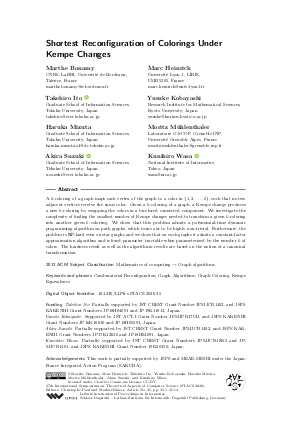@InProceedings{bonamy_et_al:LIPIcs.STACS.2020.35,
author = {Bonamy, Marthe and Heinrich, Marc and Ito, Takehiro and Kobayashi, Yusuke and Mizuta, Haruka and M\"{u}hlenthaler, Moritz and Suzuki, Akira and Wasa, Kunihiro},
title = {{Shortest Reconfiguration of Colorings Under Kempe Changes}},
booktitle = {37th International Symposium on Theoretical Aspects of Computer Science (STACS 2020)},
pages = {35:1--35:14},
series = {Leibniz International Proceedings in Informatics (LIPIcs)},
ISBN = {978-3-95977-140-5},
ISSN = {1868-8969},
year = {2020},
volume = {154},
editor = {Paul, Christophe and Bl\"{a}ser, Markus},
publisher = {Schloss Dagstuhl -- Leibniz-Zentrum f{\"u}r Informatik},
address = {Dagstuhl, Germany},
URL = {https://drops.dagstuhl.de/entities/document/10.4230/LIPIcs.STACS.2020.35},
URN = {urn:nbn:de:0030-drops-118961},
doi = {10.4230/LIPIcs.STACS.2020.35},
annote = {Keywords: Combinatorial Reconfiguration, Graph Algorithms, Graph Coloring, Kempe Equivalence}
}

 Creative Commons Attribution 3.0 Unported license
Creative Commons Attribution 3.0 Unported license


















